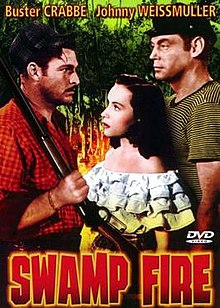
Johnny Weissmuller was an American Olympic swimmer, water polo player and actor. He was known for having one of the best competitive swimming records of the 20th century. He set world records alongside winning five gold medals in the Olympics. He won the 100m freestyle and the 4 × 200 m relay team event in the 1924 Summer Olympics in Paris and the 1928 Summer Olympics in Amsterdam. Weissmuller also won gold in the 400m freestyle, as well as a bronze medal in the water polo competition in Paris.
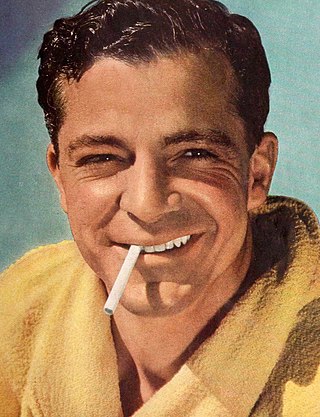
Carver Dana Andrews was an American film actor who became a major star in what is now known as film noir. A leading man during the 1940s, he continued acting in less prestigious roles and character parts into the 1980s. He is best known for his portrayal of obsessed police detective Mark McPherson in the noir Laura (1944) and his critically acclaimed performance as World War II veteran Fred Derry in The Best Years of Our Lives (1946).
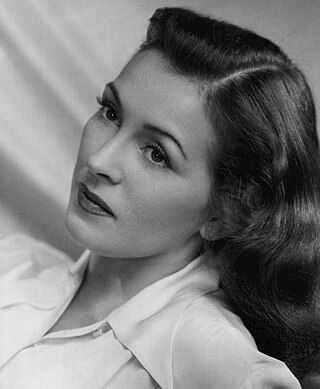
Nancy Kelly was an American actress in film, theater, and television. A child actress and model, she was a repertory cast member of CBS Radio's The March of Time, and appeared in several films in the late 1920s. She became a leading lady upon returning to the screen in the late 1930s, while still in her teens, and made two dozen movies between 1938 and 1946, including portraying Tyrone Power's love interest in the classic Jesse James (1939), which also featured Henry Fonda, and playing opposite Spencer Tracy in Stanley and Livingstone, later that same year. After turning to the stage in the late 1940s, she had her greatest success in a character role, the distraught mother in The Bad Seed, receiving a Tony Award for Best Actress in a Play for the 1955 stage production and an Academy Award nomination as Best Actress for the 1956 film adaptation, her last film role. Kelly then worked regularly in television until 1963, then took over the role of Martha in the original Broadway production of Who's Afraid of Virginia Woolf? for several months. She returned to television for a handful of appearances in the mid-1970s.

Maureen O'Sullivan was an Irish actress who played Jane in the Tarzan series of films during the era of Johnny Weissmuller. She starred in dozens of feature films across a span of more than half a century and performed with such actors as Laurence Olivier, Greta Garbo, Fredric March, William Powell, Myrna Loy, Marie Dressler, Wallace Beery, Lionel Barrymore, the Marx Bros. and Woody Allen. In 2020, she was listed at number eight on The Irish Times list of Ireland's greatest film actors.
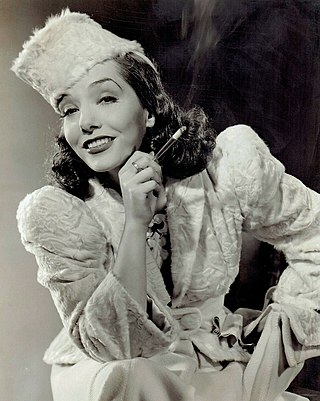
María Guadalupe Villalobos Vélez, known professionally as Lupe Vélez, was a Mexican actress, singer, and dancer during the Golden Age of Hollywood cinema.

Johnny Sheffield was an American child actor who, between 1939 and 1947, portrayed Boy in the Tarzan film series and, between 1949 and 1955, played Bomba the Jungle Boy.

Tarzan and the Leopard Woman is a 1946 American action film based on the Tarzan character created by Edgar Rice Burroughs and portrayed by Johnny Weissmuller. Directed by Kurt Neumann, the film sees Tarzan encounter a tribe of leopard-worshippers. It was shot in the Los Angeles County Arboretum and Botanic Garden. Its plot has nothing in common with Burroughs' 1935 novel Tarzan and the Leopard Men.

Bruce Bennett was an American film and television actor who prior to his screen career was a highly successful college athlete in football and in both intercollegiate and international track-and-field competitions. In 1928 he won the silver medal for the shot put at the Olympic Games held in Amsterdam. Bennett's acting career spanned more than 40 years. He worked predominantly in films until the mid-1950s, when he began to work increasingly in American television series.
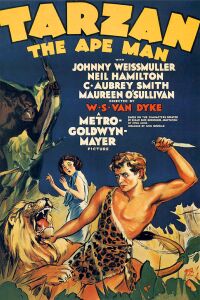
Tarzan the Ape Man is a 1932 pre-Code American action adventure film released by Metro-Goldwyn-Mayer featuring Edgar Rice Burroughs' famous jungle hero Tarzan and starring Johnny Weissmuller, Neil Hamilton, C. Aubrey Smith and Maureen O'Sullivan. It was Weissmuller's first of 12 Tarzan films. O'Sullivan played Jane in six features between 1932 and 1942. The film is loosely based on Burroughs' 1912 novel Tarzan of the Apes, with the dialogue written by Ivor Novello. The film was directed by W.S. Van Dyke. Metro-Goldwyn-Mayer released two remakes of Tarzan, the Ape Man in 1959 and in 1981, but each was a different adaptation of Rice Burroughs' novel. It is also the first appearance of Tarzan's famous yell.
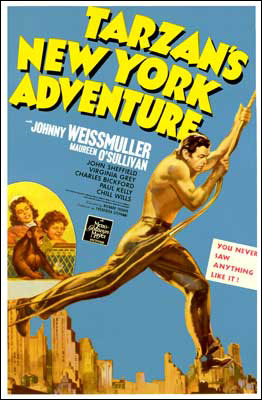
Tarzan's New York Adventure is a 1942 black-and-white adventure film from Metro Goldwyn Mayer, produced by Frederick Stephani, directed by Richard Thorpe, that stars Johnny Weissmuller and Maureen O'Sullivan. This was the sixth and final film in MGM's Tarzan series and was the studio's last Tarzan feature until 1957's Tarzan and the Lost Safari. Although Tarzan's New York Adventure includes scenes set in New York, as well as the customary jungle sequences, it is yet another Tarzan production primarily shot on MGM's back lots.
The Tarzan yell or Tarzan's jungle call is the distinctive, ululating yell of the character Tarzan as portrayed by actor Johnny Weissmuller in the films based on the character created by Edgar Rice Burroughs starting with Tarzan the Ape Man (1932). The yell was a creation of the movies based on what Burroughs described in his books as simply "the victory cry of the bull ape."

Tarzan and His Mate is a 1934 American pre-Code action adventure film based on the Tarzan character created by Edgar Rice Burroughs. Directed by Cedric Gibbons, it was the second in the Tarzan film series and starred Johnny Weissmuller and Maureen O'Sullivan.
Kurt Neumann was a German-born film director who specialized in science fiction movies in his later career.

Tarzan Finds a Son! is a 1939 Tarzan film based on the character created by Edgar Rice Burroughs. It was the fourth in the MGM Tarzan series to feature Johnny Weissmuller as the "King of the Apes" and the fourth of six films in which he stars with Maureen O'Sullivan as Jane; following this pairing was Tarzan's Secret Treasure (1941) and Tarzan's New York Adventure (1942).
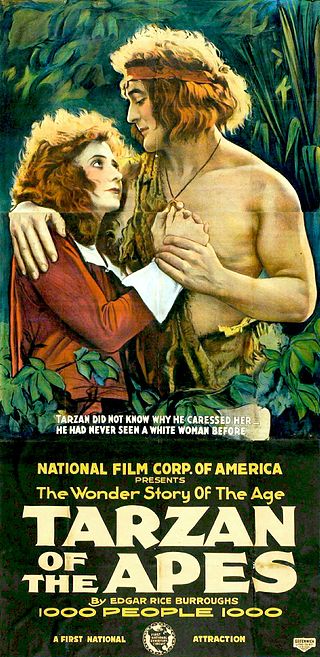
Tarzan, a fictional character created by Edgar Rice Burroughs, first appeared in the 1912 novel Tarzan of the Apes, and then in twenty-four sequels by Burroughs and numerous more by other authors. The character proved immensely popular and quickly made the jump to other media, first and most notably to comics and film.
Pine-Thomas Productions was a prolific B-picture unit of Paramount Pictures from 1940–1957, producing 81 films. Co-producers William H. Pine and William C. Thomas were known as the "Dollar Bills" because none of their economically made films ever lost money. "We don't want to make million dollar pictures," they said. "We just want to make a million dollars."
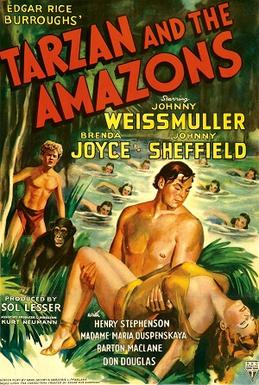
Tarzan and the Amazons a 1945 American adventure film starring Johnny Weissmuller in his ninth outing as Tarzan. Brenda Joyce plays Jane, in the first of her five appearances in the role, and Johnny Sheffield makes his sixth appearance as Boy. Henry Stephenson and Maria Ouspenskaya co-star.

Jungle Jim is a 1948 American adventure film directed by William Berke and starring Johnny Weissmuller. It is based on Alex Raymond's Jungle Jim comic strip and was distributed by Columbia Pictures. It is the first picture in the Jungle Jim series that consists of 16 films originally released between 1948 and 1955.

Albuquerque is a 1948 American Cinecolor Western film directed by Ray Enright and starring Randolph Scott, Barbara Britton, George "Gabby" Hayes, and Lon Chaney Jr. Based on the novel Dead Freight for Piute by Luke Short, with a screenplay by Gene Lewis and Clarence Upson Young, the film is about a man who is recruited by his corrupt uncle to inherit his freight-hauling empire in the southwest, and who eventually defects to his uncle's honest business rival.

Captive Girl is the fourth Jungle Jim film produced by Columbia Pictures. It was directed by William Berke and starred Johnny Weissmuller as the title character. It was also Weissmuller's second teaming with his fellow former Tarzan and Olympic Gold Medal swimming champion Buster Crabbe after Swamp Fire (1946). The film was the only feature film appearance of Anita Lhoest who was a swimming champion and cellist.
